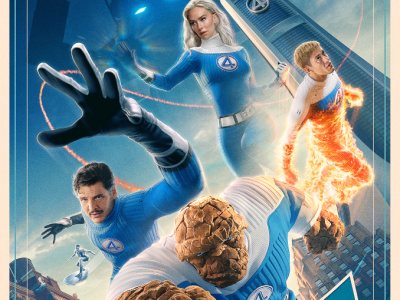
We recently caught up with Image Publisher Eric Stephenson to talk about the comics market and Image’s place in it. In Part 3 of this three part interview, Stephenson talks about what makes Image unique, and argues that "over the last 20 years, you can’t point to anything new that has been created by Marvel and DC that’s had any lasting impact." In Part 1, Stephenson talked about his view of the comics market, including the revelation that Saga #1’s four printings now total around 70,000 copies, and discusses what numbers are revealed and what they tell us. And in Part 2, Stephenson talked about the digital and graphic novel portions of the market, and reveals that digital is now a “double digit percentage” of Image’s sales.
Image has a unique position on the creator’s rights issue as part of your formation. Where is Image in the current context?
We’re in the same place where we’ve always been. Image’s deal hasn’t really changed in the last 20 years. The various partners have their own studios set up to operate somewhat differently than how Image Central is, but Image Central is the main publishing arm of the company and things are exactly the same as when we started. And by that I mean that everything we publish is 100% creator owned. It’s kind of sad to me when I see a situation like with Chris Roberson. People talk to me about what’s going on with the Watchmen stuff. If Image comics had been around when Allen Moore and Dave Gibbons wanted to do Watchmen, they would have had someplace else they could have gone to do that type of work. The situation that developed out of what did or didn’t happen with those contracts would have been irrelevant because they would have had a deal that offered them 100% creator ownership.
One of the issues in the marketplace is big publishers have control of characters, which in some cases have 70 years of history behind them. As a publisher focused on new original work owned by the creators, how do you counteract that momentum in trying to approach the market? How do you compete with publishers with well-established intellectual property?
We compete because people like new stuff. I wrote about this on my blog a while ago. If you look at the success stories over the last 20 years (start with Sandman, which is a weird deal between DC and Neil [Gaiman]), and moving up until now, you can’t point to anything new that has been created by Marvel and DC that’s had any lasting impact, but there are all these things, whether it’s Bone, Hellboy, Sin City, The Walking Dead or Y: The Last Man, that are all tremendously successful properties that have done especially well as trade paperback sales both in and outside the comics market.
Those things support the fact that there’s an audience for new material. Is there an audience for superhero stuff? Of course, all of the DC and Marvel superhero stuff that goes back 50, 60, 70 years, those people are going to be there, but I think there’s an audience that craves something new. Once you’ve read a story about Spider-Man fighting the Green Goblin for the dozenth time, I think you get hungry for something else. I think there are publishers out there who provide that something else.
We talked about Saga and The Walking Dead, what other Image projects are you most excited about this year?
Ed Brubaker and Sean Phillip’s Fatale is an excellent book and has been very well received.
I’ve been really excited about the fact that Jonathan Hickman not only came back to Image to do more work after enjoying a lot of success outside the company, but he came back with two ongoing titles, which he hadn’t done here before. Everything he did before were miniseries. Secret and The Manhattan Projects are his first ongoing creator owned projects.
The Grant Morrison and Darick Robertson collaboration Happy!—I can’t wait. That will be out in September.
Anything else for summer or fall with good sales potential?
I just got the finished first issues of something that I cannot wait to hear people’s reaction to: Howard Chaykin’s Black Kiss 2. For anyone who was around for the first Black Kiss, it really does put the "adult" in adult material. This one pushes the boundaries even more. I’m curious what people will make of that.
You’ve got such a unique structure at Image. Are there unique challenges to functioning with individual creators and the studios of the various owners?
Back when Image first started there was some contentiousness between some of the studios, especially when Larry Marder was running things. He had to be the go between for guys for Jim Lee and Rob Liefeld and there was competition among the various studios, and that doesn’t really exist anymore. Todd [McFarlane] does what he does with Spawn and Haunt; Top Cow are settled into publishing The Darkness, Witchblade and Artifacts; Erik Larsen does Savage Dragon; Robert Kirkman has the Skybound titles, which are The Walking Dead, Invincible, Super Dinosaur; and [Jim] Valentino has Shadowline and he does a lot of more indy-centric stuff.
Nobody’s jockeying to get past one another; everyone’s working toward putting out the best material they can. Whereas Larry had to mend fences at times, that’s not something I have to do at all. In that respect, that side of the job is tremendously easy. It’s very easy to work with all of those folks, and in terms of the individual creators, there are instances when it’s tough to juggle things, but for the most part, I would be really hard pressed to give you something that’s I would define as a challenge.
Any other thoughts you want to share with the comic retailers?
I don’t want to sound like I’m browbeating people, but I do have something that I’ve talked about in interviews and on my blog. A recent frustration is the FOC, which stands for "Final Order Cut-off" and what has been happening very, very consistently, not just this year but leading up to this year, is that we will get those final orders and they’re not final. After we have set our print run based on "final" orders, those orders continue to go up and they will continue to go up right up until the point that they book is in the stores. It’s been printed based on the orders we had at FOC, we’ve gauged what we’re doing our overprint on. And we’ve have instance after instance, what we overprinted winds up being wrong and that’s frustrating, because it doesn’t help us and it doesn’t help the retailers. We’re both in the business of selling comics and if we didn’t print enough comics to sell, then we’re all at a loss.
My thing would be to try to treat that final order cut-off as what the name implies. Stick to the finality of that instead of coming in after the fact and doing a bunch of advance reorders that might not be filled.
So have faith, is what you’re saying?
Exactly. It’s funny because somebody said "if you have faith in your product, you’ll print more," and I can have all the faith in the world for a product [but] my main job is to be custodian of all these different creators’ material. Part of that custodianship is making sure they’re not throwing money away. If every book that I thought would have a huge audience, I printed with wild abandon, there would instances where people would be stuck with a lot of inventory, which means they get stuck with storage fees and crate charges that they don’t need. I can’t just go back to them and say "I had a lot of faith in your books" and now you’re going to eat X number of books. The way we do things is we get the information from the retailers and we act on that information. My whole thing is give us the best information possible and we will print accordingly.
Click here to go back to Part 1.
Click here to go back to Part 1.







